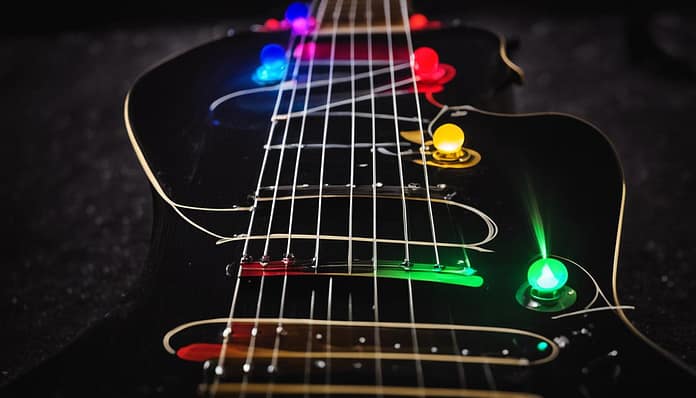This post may contain affiliate links. As an Amazon associate, Google associate as well as associate for other programs, Guitar & Music Institute may earn commissions from qualifying purchases.

Learning to play the guitar is an exciting journey that requires dedication and effective practice. Whether you’re a beginner looking to improve your skills or an experienced player aiming for mastery, implementing the right practice techniques is crucial. In this article, we will explore five essential guitar practice tips that will help you enhance your playing and make steady progress towards your goals.
- The “5 X Rule” is a powerful practice tip that involves perfecting something by playing it flawlessly five times in a row.
- Regular, focused practice is essential for guitar development, and fundamentals should not be overlooked.
- Using a metronome helps improve timing and rhythm, while actively transcribing music enhances listening skills.
- Practicing chord transitions and clarity is vital for smooth playing in songs and chord progressions.
- Establishing a consistent practice schedule and distraction-free environment enhances productivity and motivation.
By incorporating these guitar practice tips into your routine, you can elevate your playing skills and achieve mastery. Check out our latest free and paid guitar books and downloads at https://gmiguitarshop.com/ to further enhance your guitar journey.
The Importance of Regular, Focused Practice
Regular, focused practice is crucial for guitar development. Without it, progress can stagnate. Many players neglect the fundamentals because they may seem basic or unexciting, but they are essential for building a strong foundation.
Using a metronome is a valuable tool for developing timing and maintaining a steady pace. It is especially important for practicing odd time signatures and tempo changes found in genres like jazz, rock, and classical music.
Starting slow and gradually increasing speed is also key to learning new skills effectively. This allows you to focus on proper technique and accuracy before building up speed. It’s like building a sturdy house – you lay a solid foundation before constructing the walls and roof.
Transcribing music by ear is another valuable practice method. It helps develop active listening skills and a deeper understanding of music. By figuring out melodies and solos by ear, you train your ears to recognize and replicate different musical elements.
The CAGED system is a helpful method for navigating the fretboard and learning chords and scales in different positions. It provides a roadmap for finding chords all over the neck, allowing you to play in various keys and positions effortlessly.
Warm-up exercises are essential before diving into your practice session. They help warm up your muscles, increase finger agility, and reduce the risk of injury. Just as athletes warm up before a game or competition, guitarists need to warm up their fingers before playing challenging music.
Setting goals and creating a structured practice routine can help maintain consistency and motivation. When you have specific goals in mind and a plan to work towards them, you are more likely to stay focused and make progress. Whether it’s learning a new song, mastering a specific technique, or improving your improvisation skills, setting targets will guide your practice sessions and give them purpose.
Remember, regular, focused practice is the key to unlocking your full potential as a guitarist. By dedicating time to practice every day, working on fundamentals, using a metronome, transcribing music, implementing the CAGED system, warming up, and setting goals, you will see significant improvement in your playing.
| Benefits of Regular, Focused Practice | Techniques and Methods |
|---|---|
| 1. Consistent progress | 1. Practice with a metronome |
| 2. Improved technique | 2. Transcribe music by ear |
| 3. Increased musical understanding | 3. Utilize the CAGED system |
| 4. Finger agility and injury prevention | 4. Warm-up exercises |
| 5. Motivation and goal setting | 5. Establish a structured practice routine |
Practicing Chords and Transitioning Between Them
When it comes to mastering the guitar, practicing chords and transitioning between them is essential. This section will provide you with valuable techniques and exercises to improve your chord playing skills, ensuring clarity and smooth transitions.
Starting Slow and Focusing on Clarity
When practicing chords, it’s important to start slow and prioritize clarity and accuracy. Take your time to position your fingers correctly and ensure each note rings out clearly. This initial focus on precision will set a solid foundation for building speed and fluidity in your chord transitions.
Using a Metronome and Gradually Increasing Speed
A metronome can be a valuable practice tool for developing smooth chord transitions. Begin by strumming each chord four times at a comfortable speed. As you become more comfortable, gradually increase the tempo, challenging yourself to maintain accuracy and clarity.

Incorporating Chord Progressions and Musical Context
While practicing individual chords is important, incorporating chord progressions into your practice sessions allows for a more musical context. This helps you apply your chord knowledge in actual songs, enhancing your playing skills and musicality.
Benefits of Practicing with a Metronome
Practicing with a metronome offers more than just timing assistance. It can also be a valuable tool for setting practice goals. By gradually increasing the metronome speed, you can challenge yourself to improve your chord transitions and develop a sense of rhythm and timing.
Take advantage of resources such as the Uberchord App, which provides chord libraries, lessons, and exercises to help you learn chords and improve your chord changes.
| Benefits of Practicing Chords and Transitioning | Techniques and Exercises |
|---|---|
| Improves chord clarity | Start slow and focus on accuracy |
| Develops smooth chord transitions | Use a metronome and gradually increase speed |
| Applies chord knowledge in songs | Incorporate chord progressions into practice sessions |
| Enhances rhythm and timing | Practice with a metronome |
By incorporating these techniques and exercises into your practice routine, you will notice significant improvements in your chord playing and transitioning abilities. Remember, consistency and focused practice are key to mastering the guitar.
Don’t forget to check out our latest free and paid guitar books and downloads at https://gmiguitarshop.com/.
Establishing a Practice Schedule and Environment
To make consistent progress in your guitar playing, it is crucial to establish a practice schedule and create a suitable practice environment. By dedicating specific time slots for practice and minimizing distractions, you can maximize the effectiveness of your practice sessions and achieve your guitar goals.
Practice Schedule
A well-structured guitar practice schedule is essential for maintaining consistency and making progress. Determine a specific time that works best for you, whether it’s in the morning, afternoon, or evening, and stick to it. This consistent practice routine will help you build a habit and make practicing feel natural.
To keep yourself accountable and track your progress, consider using a practice sheet or utilizing the features of the Uberchord App. These tools can help you set goals, schedule practice reminders, and monitor your improvement over time. By having a clear plan and schedule, you can approach your guitar practice with focus and intention.
Practice Environment
Creating a comfortable and distraction-free practice environment is crucial for effective and focused practice. Ideally, find a quiet space where you can fully hear yourself play and concentrate on your practice material. Minimizing external distractions such as noise or interruptions will allow you to immerse yourself in your practice and maximize your concentration.
Additionally, ensure that your practice space is ergonomically designed for comfort. Use a suitable chair or stool that provides proper support for your posture, and adjust your guitar strap to a height that allows for relaxed playing. Making these small adjustments will help prevent discomfort or strain during longer practice sessions.

Creating a practice environment that appeals to you visually can also enhance your motivation. Decorate your practice area with inspirational posters, photos of your favorite guitarists, or any other elements that inspire and uplift you. This will help create a positive and inspiring atmosphere that encourages consistent practice.
Finally, set specific goals for yourself in your practice sessions. Whether it’s learning a specific song, mastering a challenging technique, or improving your speed and accuracy, having clear objectives will keep you motivated and give you a sense of accomplishment as you achieve each milestone. Remember to celebrate your progress along the way and enjoy the journey of becoming a better guitarist.
By establishing a practice schedule and creating a conducive practice environment, you are setting yourself up for success. Consistent practice, free from distractions, in a comfortable space will allow you to focus on your guitar playing and make significant strides in your musical journey.
Conclusion
By implementing these essential guitar practice tips into your routine, you can greatly enhance your guitar skills and make consistent progress towards achieving mastery. The “5 X Rule” provides a simple yet powerful approach to learning and practicing new material. By slowing down and practicing something until you can play it perfectly five times in a row, you train yourself to play without mistakes and build confidence in your abilities.
To further improve your guitar playing, regular and focused practice with the use of a metronome is essential. This helps develop your timing and technique, allowing you to play with precision and accuracy. Practicing chords and transitioning between them is another important aspect of effective practice. By working on chord clarity and smooth transitions, you can enhance your overall playing and make your guitar sound more seamless and professional.
Creating a practice schedule and environment that is free from distractions is crucial for maintaining consistent progress. Establishing a dedicated practice time and finding a quiet, comfortable space to play allows you to fully concentrate and immerse yourself in your practice material. Setting goals, tracking your progress, and staying motivated are also key factors in achieving mastery. Consider using a practice sheet or an app like Uberchord to keep track of your goals and monitor your improvement.
In conclusion, with dedication and consistent practice using these guitar practice tips, you can unlock your full potential and achieve mastery on the guitar. For more resources and materials to support your guitar journey, check out our latest free and paid guitar books and downloads at https://gmiguitarshop.com.
FAQ
What is the 5 X Rule for guitar practice?
The 5 X Rule is a practice tip that suggests practicing something until you can play it perfectly five times in a row. This helps train you to play without mistakes, builds confidence, and minimizes frustration.
How important is regular and focused practice for guitar development?
Regular, focused practice is crucial for guitar development. Neglecting the fundamentals and skipping practice can hinder progress. It is important to practice consistently to build a strong foundation and improve skills.
How can a metronome be helpful in guitar practice?
A metronome is a valuable tool for developing timing and maintaining a steady pace in guitar practice. It is especially important for practicing odd time signatures and tempo changes found in genres like jazz, rock, and classical music.
How can I effectively practice chords and transitioning between them?
To practice chords effectively, start slow and focus on clarity and accuracy. Strum each chord four times and gradually increase speed with a metronome. Aim to eliminate pauses and ensure that each note rings out clearly.
What are some tips for establishing a practice schedule and environment?
To establish a practice schedule, choose a specific time that works with your current schedule and stick to it. Create a comfortable, distraction-free practice environment by finding a quiet space where you can fully hear yourself play and concentrate on your practice material.
Source Links
- https://guitardomination.net/guitar-practice/
- https://www.pickupmusic.com/blog/the-5-most-impactful-practice-methods-for-guitar
- https://www.uberchord.com/blog/beginners-guide-to-guitar-practice/
This post may contain affiliate links. As an Amazon associate, Google associate as well as associate for other programs, Guitar & Music Institute may earn commissions from qualifying purchases.



















